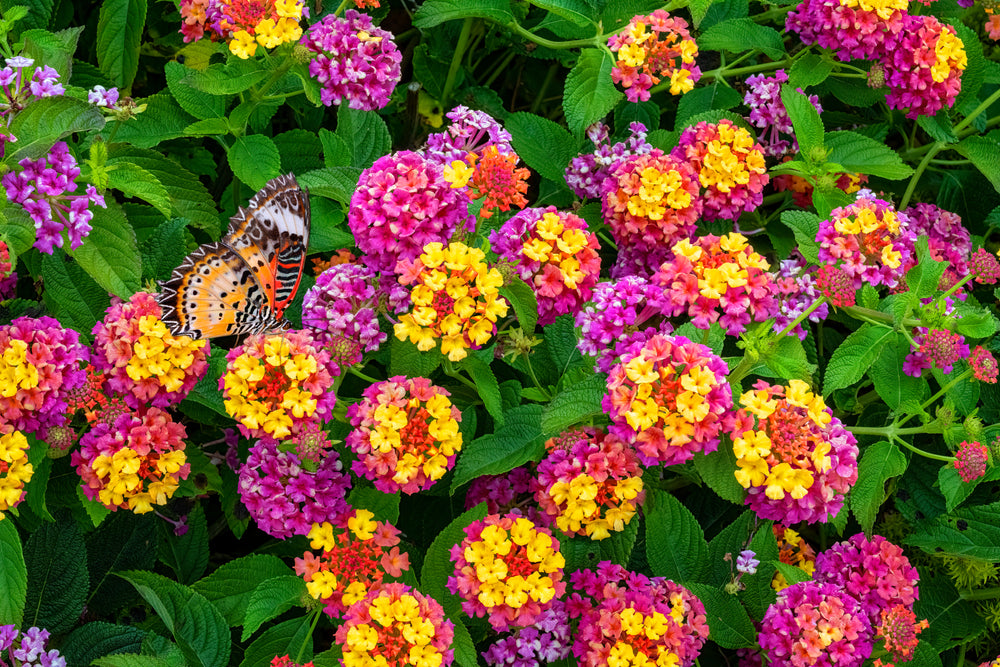Lantana plants are renowned for their vibrant and cheerful blossoms, which makes them a popular choice among gardeners worldwide. These versatile plants come in various types, including shrubs, trees, and creeping varieties, each offering its unique charm.
From their striking Lantana flowers to their resilience in various climates, there's much to appreciate about these plants. However, like any species, they come with their own set of considerations, including care tips to ensure they thrive without becoming invasive nuisances.
• Significance of Lantana Plants

One of the significant advantages of lantana plants is their ability to attract pollinators such as bees and butterflies. Their bright and fragrant flowers act as magnets for these beneficial insects, aiding in the pollination of surrounding plants and promoting biodiversity in the garden.
Additionally, the long-lasting blooms of Latana plants ensure a splash of color throughout the growing season, enhancing the visual appeal of any outdoor space. Lantana bushes and lantana shrubs are also prized for their low maintenance nature. However, you must remember that these species easily become very invasive and difficult to control if not managed properly from the very beginning.
• Disadvantages of Latana Plants as an Invasive Species

While Lantana plants offer many benefits, they can also pose challenges when allowed to grow unchecked in certain environments. In some regions, particularly warmer climates, Lantana has earned a reputation as an invasive species. Its rapid growth rate and prolific seed production enable it to outcompete native vegetation, leading to ecological imbalances.
Therefore, it's crucial to exercise caution when introducing Lantana to new areas and to monitor its spread carefully.
• Lantana Plants Care Tips & Tricks
To keep your Lantana plants thriving while preventing them from becoming invasive, consider the following care tips:

1. Choosing the Best Soil for Lantana
Plant your Lantana in a well-draining soil enriched with organic matter. Ensure they receive ample sunlight, as they thrive in full sun conditions. These plants need proper aeration and drainage in order to grow properly.
2. Watering
While established Lantana plants are drought-tolerant, they benefit from regular watering, especially during dry spells. Avoid overwatering your plants, as this can lead to root rot.
3. Pruning
Regular pruning helps maintain the shape and size of your Lantana plants while promoting flowering. Remove spent blooms to encourage continuous blooming throughout the season. Remember to prune your plants in time so as to avoid them becoming large, invasive species that have the capacity to overpower other local species of plants.
Pruning is an important factor when it comes to preventing over-growing these plants as letting them grow freely without being checked will lead to uncontrollable growth.
4. Fertilization

Apply a balanced fertilizer during the growing season to provide your Lantana with essential nutrients. However, avoid excessive fertilization, as this can lead to lush foliage at the expense of flowers.
5. Pest and Disease Management
Keep an eye out for common pests such as aphids and spider mites, and treat infestations promptly. Additionally, ensure good air circulation around your plants to prevent fungal diseases.
• Lantana Plant Benefits: Can An Invasive Plant Have Benefits?

1. Uses in the Food Industry
Latana plant extracts are often used in the food industry. They are used as natural preservatives and are considered to have many antioxidant, antimicrobial, and anti-inflammatory properties. These properties are said to increase the shelf-life of foods.
The extracts of Latana plants are often used as natural food coloring as red Latana plants have a deep red and yellow hue.
Oftentimes, these are also used to add aroma to food items.
2. Health Benefits
In traditional medicine, Latana plants have been used for centuries. They are said to treat various common health issues such as fever, colds, coughs, headaches, skin infections, and digestive problems.
These plants are also said to have anti-inflammatory, anti-bacterial, and anti-fungal properties. Moreover, what makes them more valuable is antioxidant and anti-cancer properties, and their benefits for cardiovascular health.
Despite its many health benefits, there are certain risks that come along with Latana plants and their usage. If taken in large doses, it can be pretty risky and dangerous as it can cause nausea, vomiting, dizziness, and headaches. In the long run and on the more stark side, it can also lead to liver damage, kidney damage, and even death in some cases.
So, in any case, exercising caution is very important when consuming anything that contains Latana extracts in order to remain safe.










